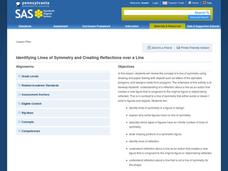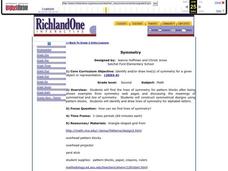Curated OER
Identifying Lines of Symmetry and Creating Reflections over a Line
Fifth graders review the concept of a line of symmetry by using pieces of paper that have pictures such as, letters of the alphabet, polygons, and designs made from polygons in order to determine if they have symmetry. The fine,...
Curated OER
Symmetry
Second graders find the lines of symmetry in pattern blocks and alphabet letters. In this symmetry activity, 2nd graders discuss what symmetry is, view examples of lines of symmetry and apply what they have learned by finding the line of...
Curated OER
A World of Symmetry
Middle schoolers identify lines of symmetry. In this symmetry lesson, students create objects and identify their lines of symmetry. They answer questions about lines of symmetry. Middle schoolers cut shapes out of...
Curated OER
Identifying Lines of Symmetry
Students calculate the lines of symmetry using polygons. In this geometry lesson, students graph, compare and estimate using collected data. They identify different attributes to the polygons based on their sides.
Curated OER
Symmetry
Third graders find symmetry in nature. For this symmetry lesson, 3rd graders discover that symmetry is in nature and our everyday world. Students examine the alphabet for symmetrical letters then create their own artwork showing symmetry.
Illustrative Mathematics
The Geometry of Letters
Use the alphabet as a tool for teaching your class about geometric figures. Break apart capital letters into line segments and arcs. Classify angles as right, acute, or obtuse. Identify parallel and perpendicular lines. An excellent...
Curated OER
Symmetry Monsters
Students discuss and study the word symmetry. They examine letters of the alphabet, shapes, and artwork and decide if they are symmetrical or not. Then they create their own symmetry monsters.
Curated OER
Let's Learn about Symmetry
Students explore symmetry in architecture. For this cross curriculum art and architecture lesson, students fold paper to illustrate symmetry and identify symmetrical and asymmetrical shapes. Students observe photographs...
Curated OER
Mira, Mira on the Wall: Reflections
Students investigate and perform reflections and symmetry. In this geometry lesson, students compare and contrast the relationship between reflections and symmetries.
Curated OER
Lesson #2 Absolute Value and Symmetry
Students investigate absolute value functions. In this Algebra II/Pre-calculus/Calculus lesson, students explore the formal definition of absolute value and apply the piece-wise definition to solve inequality problems. ...
Curated OER
Folding Shapes; Are the Sides the Same?
Second graders explore geometry by experimenting with fold-ables. In this geometric shapes lesson, 2nd graders utilize cutout shapes from construction paper which they experiment with by folding. Students examine the symmetry and...
Curated OER
Biology: Butterfly Activities
Second graders examine various types of butterflies and insects around their school. They identify differences between beetles and butterflies. Students examine books about butterflies, complete symmetry drawings, and make ladybug key...











